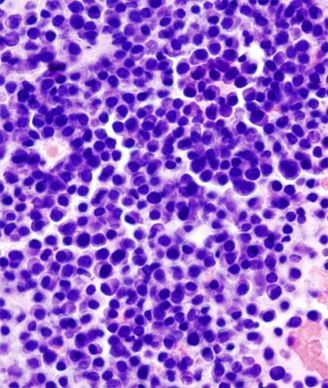Sensory Dysfunction Prevalent in Multiple Myeloma Patients
Multiple myeloma patients may already suffer from sensory deficits prior to treatment, likely due to disease-related decreases in peripheral innervation density.
Histopathologic image of multiple myeloma; source: KGH, Wikimedia Commons

Patients with multiple myeloma may already be suffering from subclinical sensory deficits prior to undergoing treatment for their disease, most likely due to disease-related decreases in peripheral innervation density.
Based on findings from a study, published recently in the Journal of Clinical Oncology, Alyssa K. Kosturakis, of the University of Texas MD Anderson Cancer Center, and colleagues concluded that treatment-naive patients with multiple myeloma are experiencing nervous system complications more often than previously thought.
According to background information in the article, fewer than one in five patients with multiple myeloma present with peripheral neuropathy prior to undergoing treatment. However, during treatment, peripheral neuropathy is a common cause of dose reduction or discontinuation of treatment.
Kosturakis and colleagues wanted to determine the prevalence of subclinical peripheral neuropathy in treatment-naive patients with multiple myeloma and examine if any deficits were linked with decreased peripheral innervation density.
They conducted a small study that included 27 patients with multiple myeloma and 30 matched healthy volunteers. Patients had skin temperature, sensorimotor function, and detection thresholds for temperature, sharpness, and low-threshold mechanical stimuli (using von Frey monofilaments and bumps) analyzed. In addition, Meissner corpuscle density in the fingertips was assessed with in vivo laser reflectance confocal microscopy.
No significant difference between patients and volunteers was found for the sharpness detection tests.
Patients had higher touch detection thresholds at the thenar eminence and volar forearm than did healthy volunteers. Specifically, touch detection threshold found in the palm (0.26 g vs 0.52 g; P < .01) and forearm (0.32 g vs 0.56 g; P < .05) were higher for patients compared with the volunteers. The researchers also found that patients had significant impairment of bumps detection.
Using both the dominant hand and the non-dominant hand, patients had a significantly slower completion time for the sensorimotor slotted pegboard task compared with the healthy volunteers. Taken together, the researchers wrote that “these findings indicate that patients with multiple myeloma with no outward signs or symptoms of neuropathy have impaired A-beta fiber function before chemotherapy.”
Skin temperature tests revealed that patients had a significantly higher threshold for warmth detection at all of the tests sites compared with healthy volunteers.
Next, the researchers assigned each patient an overall neuropathy score by adding the number of observations for each participant where a measure was more than two standard deviations from the mean among the volunteers. Data showed that 81.5% of the patients with multiple myeloma had at least one out of range measurement compared with 33.3% of the volunteers.
Finally, a subset of patients underwent noninvasive confocal imaging of the fingertip of their fifth digit. The examination revealed that patients had significantly decreased mean density of Meissner corpuscle compared with the volunteers (P < .01).
“Patients showed decreased density of Meissner corpuscle by confocal imaging that was correlated with their ability to detect small bumps in the bumps detection test,” the researchers wrote. “These data suggest that a decrease in tactile sensitivity is well correlated with Meissner corpuscle density as visualized by in vivo confocal imaging and is consistent with studies comparing bump threshold with Meissner corpuscle density using quantified skin biopsy.”
Based on what is already known about neuropathy occurring during treatment, and these new findings, the researchers suggested that patients with multiple myeloma at risk for neuropathy undergo careful screening and treatment.
Navigating AE Management for Cellular Therapy Across Hematologic Cancers
A panel of clinical pharmacists discussed strategies for mitigating toxicities across different multiple myeloma, lymphoma, and leukemia populations.